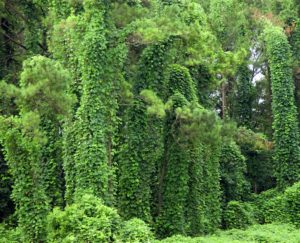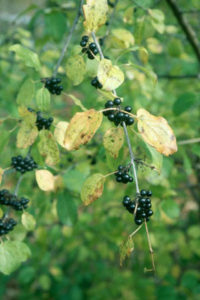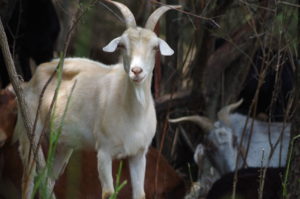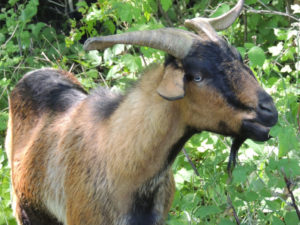
“In Georgia, the legend says
That you must close your windows
At night to keep it out of the house
The glass is tinged with green, even so
As tendrils crawl over the fields…”
—James Dickey (1)
I grew up in Georgia, where on a hot, humid summer day you could almost hear the hiss of growing vegetation, especially the Kudzu as it climbed over fence posts and encroached upon the roadside, the king of invasive species. In Florida you worry about the alligators along the roadside if you have a flat tire; in Georgia, beware the Kudzu.
Invasive species, animal and plant, are an issue in all ecosytems. Imported from distant (and not-so-distant) areas both by accident and misguided intent, invasive species are species that have escaped the checks and balances of natural competitors and predators that existed in their native habitats. This lack of predation and competition enables them to outcompete and overrun other species.
Kudzu may be one of the most recognized invasive species in the United States, but it’s probably not the worst. The zebra mussel is an aquatic animal that has invaded our waterways in Wisconsin. Oak savannahs and prairie ecosystems in the Midwest United States are threatened by many invasive plant species like garlic mustard and blister parsnip. The USDA maintains an extensive invasive species list so.
The Invasive Problem

Managing invasive species is as much an economic imperative as it is an ecological one (3). In the United States, the Great Lakes sport and commercial fishing industries, which are valued at 4.5 billion dollars and generate 81,000 jobs, are threatened by invasive animal species that eat the eggs of sport fish (3). Property values along lakes that have been invaded by Eurasian water milfoil have decreased by as much as 19%. The Wisconsin Electric Power Company spends more than a million dollars per year to keep invasive zebra mussels from clogging intake and distribution pipes on their Lake Michigan power plants. On land, invasive plants such as non-native buckthorn shrubs and honeysuckles keep young trees from growing, causing serious and long-term negative effects on the Wisconsin forestry industry (3).
However, managing invasive plant species is difficult and expensive. Herbicides can be used, but herbicides can lose effectiveness as target species become resistant. Herbicides are also expensive, and the correct herbicide at the correct concentration must be applied in the appropriate manner to the target plant at the right time in its growth cycle. Manual control (cutting, pulling and digging) is possible in areas where invasive species are just taking hold or in small areas, but for large tracts of land, manual control isn’t practical. Large, easy-to-access areas, can be managed with mechanical methods like cutting/mowing/tilling, etc., but both native and invasive species will be affected, the site will be disturbed and soil loss is an issue. Additionally, seeds from invasive species can be spread by mowing, actually making the problem worse. Add to that the expense of equipment and equipment operators, and land management of invasive species presents a real challenge (4,5).
Enter the goat
In 2007, Chattanooga, TN, USA, deployed a herd of goats along Missionary Ridge against invading Kudzu and Hackberry trees, and The New York Times wrote about it (6). Goats are browsers, meaning they will eat woody plants like brush and weeds. They are climbers, so they can browse along ridges and rocky hills where it is difficult to operate equipment. They are relatively inexpensive to raise, and their scat is actually good for the soil. They can chew down the brush and invasive species without disturbing the soil—roots stay intact, so erosion is less of a concern. And, land managers can time the use of goats so so that they achieve the desired results. Because goats are browsers not grazers, they browse up the tree line, pulling down vines and other things that might be missed by a lawn mower (5).

Here at Promega Headquarters in Madison, WI, we have some new members on our land management team— Promega and Agrace Hospice are using goats for land management—just in time for Wisconsin’s Invasive Species Month.
The Green Goats owned by Kim Hunter of Burlington, WI, are visiting Fitchburg Center this summer. These animals are helping manage brush and invasive plants on the property around their buildings. Agrace has deployed The Green Goats previously to the woodlands around the building, with the goal of clearing the underbrush and making it more accessible. The goats will eat non-native buckthorn and invasive honeysuckle, two major problems in Wisconsin. They also eat garlic mustard, poison ivy, and smaller thistles.

Promega has piloted use of the goats this year to manage a hill of clay next to the Feynman Center on the Madison Campus. The hill is difficult to mow and overgrown with invasive plant species. The goats were expected to take two weeks to browse through all of the weeds on this hill, they completed their pilot work in five days. This leaves the land management team at Promega free to use other methods to quickly kill any emerging invasives (which they can now see thanks to the work of the goats) and give the native plants a chance.
“Goats are one part of the tool kit for land management. They don’t replace fire, traditional mowing, tilling, and chemical management, but they can be an important part of the total strategy,” says Jason Hankes, environmental and landscape manager at Promega. This year was an experiment, but Hankes thinks the goats did well and has his eyes on several other small areas of land around Promega Madison where the goats might make a significant contribution to the land management efforts.
Literature Cited
- Dickey, James. Kudzu (1963) The New Yorker May 18.
- Wisconsin Department of Natural Resources (2015) Wisconsin CH. NR 40 Invasive Species List – Plants Only. [Internet: http://dnr.wi.gov/topic/Invasives/documents/NR40plantlist.pdf Accessed June 15, 2017]
- Wisconsin Department of Natural Resources (2016) Why we should care [internet: http://dnr.wi.gov/topic/Invasives/care.html Accessed June 14, 2017]
- Wisconsin Department of Natural Resources (2016) Invasives: Control Methods [Internet: http://dnr.wi.gov/topic/invasives/control.html Accessed June 15, 2017]
- Bull, B. (2000) Using Goats for Vegetation Management Noble Research Institute [Internet: https://www.noble.org/news/publications/ag-news-and-views/2000/september/using-goats-for-vegetation-management/ Accessed June 15, 2017]
- Emery, T. (2007) In Tennessee, Goats Eat the “Vine That Ate the South” The New York Times [Internet: June 15, 2017)
Michele Arduengo
Latest posts by Michele Arduengo (see all)
- IL-6/STAT3-Regulated Long Non-Coding RNA Is Involved in Colorectal Cancer Progression - July 1, 2025
- Using Dual-Luciferase Assays to Identify the Role of Non-Coding RNAs in Disease - May 2, 2025
- An Unexpected Role for RNA Methylation in Mitosis Leads to New Understanding of Neurodevelopmental Disorders - March 27, 2025
